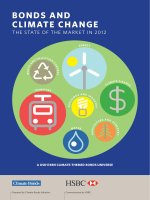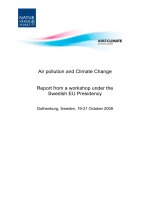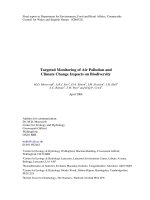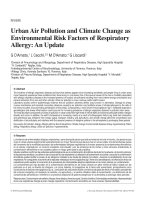ozone depletion and climate change constructing a global response oct 2005
Bạn đang xem bản rút gọn của tài liệu. Xem và tải ngay bản đầy đủ của tài liệu tại đây (3.24 MB, 276 trang )
#ONSTRUCTINGA'LOBAL2ESPONSE
/ZONE$EPLETION
AND#LIMATE#HANGE
/ZONE$EPLETION
AND#LIMATE#HANGE
-ATTHEW*(OFFMANN
#ONSTRUCTINGA'LOBAL2ESPONSE
/ZONE$EPLETION
AND#LIMATE#HANGE
/ZONE$EPLETION
AND#LIMATE#HANGE
-ATTHEW*(OFFMANN
Ozone Depletion and Climate Change
SUNY series in Global Politics
James N. Rosenau, editor
A complete listing of books in this series
can be found at the end of this volume.
Ozone Depletion and Climate Change
Constructing a Global Response
Matthew J. Hoffmann
State University of New York Press
Published by
State University of New York Press, Albany
© 2005 State University of New York
All rights reserved
Printed in the United States of America
No part of this book may be used or reproduced in any manner whatsoever
without written permission. No part of this book may be stored in a retrieval system
or transmitted in any form or by any means including electronic, electrostatic,
magnetic tape, mechanical, photocopying, recording, or otherwise
without the prior permission in writing of the publisher.
For information, address State University of New York Press,
194 Washington Avenue, Suite 305, Albany, NY 12210-23
Production by Kelli Williams
Marketing by Anne M. Valentine
Library of Congress Cataloging-in-Publication Data
Hoffmann, Matthew J., 1972–
Ozone depletion and climate change: constructing a global response /
Matthew J. Hoffmann.
p. c.m. — (SUNY series in global politics)
Includes bibliographical references and index.
ISBN 0/7914-6525-X (hardcover: alk. paper) — ISBN 0-7914-6526-8
(pbk.: alk. paper)
1. Ozone layer depletion—Environmental aspects. 2. Climate changes—
International cooperation. 3. Environmental management—International
cooperation. I. Title. II. Series.
QC879.7.H64 2005
363.738'75526—dc22 2004024571
10 9 8 7 6 5 4 3 2 1
84
Contents
List of Illustrations vii
Preface ix
Acknowledgments xi
List of Abbreviations xiii
List of Interviewees xv
Chapter 1 Participation Matters: Governing Ozone 1
Depletion and Climate Change
Chapter 2 Alternative Stories: Explaining the Rise and 21
Evolution of Universal Participation
Chapter 3 The Verbal Model: Adaptation and the 33
Norm Life Cycle
Chapter 4 Modeling the Norm Life Cycle 55
Chapter 5 Ozone Depletion: The Emergence of Universal 83
Participation
v
Chapter 6 The Governance of Climate Change I: 123
Universal Participation and the Framework
Convention on Climate Change
Chapter 7 A New Global Response? The Evolution of 161
Universal Participation and the Governance of
Climate Change
Chapter 8 The Complexity of Constructing a Global 187
Response
Notes 201
Works Cited 229
Index 249
SUNY series in Global Politics 257
vi CONTENTS
List of Illustrations
Figure 1.1 Steps of Analysis 18
Figure 4.1 Schematic of the Model 64
Figure 4.2 Population Predictions—Low Noise, 67
No Entrepreneur
Figure 4.3 Population Predictions—High Noise, 67
No Entrepreneur
Figure 4.4 Population Predictions—Low Noise, 68
Entrepreneur Present
Figure 4.5 Population Predictions—High Noise, 70
Entrepreneur Present
Figure 4.6 Public Rule Usage in Population 70
Table 4.1 Effect of the Reach of the Norm Entrepreneur 73
Table 7.1 COP 1–3 at a Glance 186
vii
This page intentionally left blank.
Preface
Ozone depletion and climate change present the international community
with enormous governance challenges. Given the large stakes involved with
mitigating or living with ozone depletion and climate change, it is no won-
der that the governance of these problems is a crucial concern on the world
political stage. Conventionally, studies focus on economic costs and benefits
and/or scientific knowledge in their analyses of environmental governance.
In contrast, this study is driven by a fundamental curiosity about the social
foundations of global environmental governance. Specifically, I find it cru-
cial to uncover how actors understand and frame the problems that they
face before attempting to explain the negotiations, treaties, rules, and insti-
tutions that most consider to be the stuff of governance. Norms form this
social foundation, shaping which actors participate, how they view “prob-
lems,” and how they approach solutions. Therefore, examining the evolu-
tion of social norms is a necessary aspect of explaining how global
environmental governance has unfolded and will unfold in the future.
This book investigates the foundations of global environmental gover-
nance for ozone depletion and climate change, tracing the evolution of par-
ticipation norms—what states are required to participate in governance
solutions—and examining how these understandings have shaped the global
response to these crucial problems. The analysis is informed by constructivist
thought about the emergence and evolution of norms as well as insights
from the study of complex adaptive systems. Combining these two ap-
proaches allows me to integrate macro level change in the normative context
through the norm life cycle with micro level change in actors through a
process of complex adaptation. The result is an enhanced understanding of
social norm dynamics and thus the foundations of governance.
ix
Methodologically, the book undertakes both formal analysis in the
form of agent-based computer simulation models and qualitative case
studies, and it thus contains my plea for methodological eclecticism. We
should not be thinking in terms of either formal analysis or case studies.
Instead, the formal analysis enhances the empirical analysis, and in turn
the empirical analysis informs modeling efforts. Solid analysis of global
governance entails a recursive process of theorizing, modeling, and em-
pirical investigation. This book reports my efforts at both modeling fun-
damental insights about the evolution of social norms and applying the
insights in detailed case analysis of the governance of ozone depletion and
climate change. The integration of multiple methods provides a much
fuller picture than either method could have independently.
The theory and methods combine to tell a story of the emergence
and evolution of participation norms and the cooperation and contesta-
tion that ensued in the ozone depletion and climate change negotiations
between 1986 and 2004. It is my hope that such an analysis will, in some
small way, lead to more effective global responses to these and other
environmental problems.
x PREFACE
Acknowledgements
I could not have completed this research and volume without the benefit
of the expertise and aid of numerous people. I would be remiss if I did not
thank Mary Durfee for diverting me from environmental engineering and
sending me into the world of IR. At The George Washington University,
Marty Finnemore, Jim Rosenau, and Susan Sell provided incredible sup-
port and guidance throughout the research process. Their advice and en-
couragement have been a continual source of motivation and direction.
Marty deserves special credit for reading innumerable drafts, for her in-
exhaustible patience with a young scholar, and for her always invaluable
advice. I owe my interest in complexity theory to Jim Rosenau who has
been an inspiration in uncountable ways. Susan worked with me on this
project from its first (very humble) beginnings and has been an incredi-
ble source of support throughout.
I am grateful to my colleagues (faculty and students) at The George
Washington University, Indiana University, and the University of Delaware
for creating stimulating academic atmospheres. A number of people deserve
special thanks for their insights and suggestions on earlier manifestations
of this book in drafts and conference papers: Claudio Cioffi-Revilla, Ian
Lustick, Audie Klotz, John Riley, Jack Moran, Kelly Kollman, Terry Casey,
Jackie McClaren, Maurits Van der Veen, Tyrone Simpson, Steve Wolcott,
and David Johnson. Joe Tonon has been a sounding board, resource, and
friend throughout this project. Alice Ba took on the onerous task of re-
viewing multiple drafts of most of this volume and her insights and sugges-
tions have been invaluable. The commentary of the anonymous reviewers
at SUNY was detailed and incredibly important in helping craft my argu-
ments and the presentation of this book, and I thoroughly appreciate the
work of Michael Rinella and Kelli Williams in sheparding me through the
xi
publication process. Finally, I want to thank Lisa Daniels, Karen McClel-
land, Ammar Wasfi, and especially Atsuko Yokoburi for research assistance
and Davy Banks for his work on the index. All are blameless in any ambi-
guity or mistakes that remain.
My interest in complexity theory and agent-based modeling would
have come to naught if it wasn’t for the advice and aid of Rob Axtell. In
addition, this research was enhanced by participating in the Santa Fe In-
stitute’s Complex Systems Summer School. For help in improving my
computer modeling skills, I would like to acknowledge my modeling
group colleagues at the Workshop on Political Theory and Policy Analy-
sis and the Center for the Study of Institutions, Population and Environ-
mental Change at Indiana University, Hugh Kelley, Dawn Parker, Tom
Evans, and especially Elinor Ostrom for her constant encouragement.
Financially, I would like to acknowledge the support of the Na-
tional Science Foundation through the Graduate Research Fellowship
Program and the Biocomplexity Initiative grant at CIPEC (Grant #
SES0083511). A General University Research grant from the University
of Delaware allowed me to hone the computer model and significantly
improve this volume.
Parts of the argument developed further in this book appeared first in
“Constructing a Complex World: The Frontiers of International Relations
Theory and Foreign-Policy Making.” Asian Journal of Political Science 11
(2) (December 2003): 37–57, and in “Entrepreneurs and the Emergence
and Evolution of Social Norms.” in 3rd Workshop on Agent-Based Simu-
lation, edited by Christoph Urban, Ghent, Belgium: SCS-Europe. I would
like to thank Marshall Cavendish International and SCS-Europe respec-
tively for permission to include the material.
Finally, I could not have completed this project without the support
of my parents, and most importantly the constant support and intellec-
tual partnership of Lena Mortensen, my best friend and wife.
xii ACKNOWLEDGMENTS
Abbreviations
ABM Agent-Based Modeling
CBDR Common but Differentiated Responsibilities
CCOL Co-ordinating Committee on the Ozone Layer
CDM Clean Development Mechanism
CFC Chlorofluorocarbon
EPA U.S. Environmental Protection Agency
ET Emissions Trading
FCCC Framework Convention on Climate Change
GEF Global Environmental Facility
INC Intergovernmental Negotiating Committee
IPCC Intergovernmental Panel on Climate Change
JI Joint Implementation
KP Kyoto Protocol
MP Montreal Protocol
NGO Nongovernmental Organization
NRDC Natural Resources Defense Council
OECD Organization for Economic Cooperation and Development
OMB Office of Budget and Management
SWCC Second World Climate Conference
UNEP United Nations Environment Program
WMO World Meteorological Organization
xiii
This page intentionally left blank.
Officials Interviewed for the Project
Stephen Anderson—December 12, 1997 (former director of Technology
Transfer and Industry Programs, EPA Global Change Division;
director, Strategic Climate Projects, EPA)
Frederick Bernthal—September 29, 1999 (former Assistant Secretary
of State, OES, 1988–1990 IPCC Working Group II Chair,
1990–1991)
Sue Biniaz—December 3, 1998 (Legal Advisor, U.S. Department of State,
OES Bureau)
Eileen Claussen—January 26, 1999 (former director EPA Atmospheric and
Indoor Air Programs and former Assistant Secretary of State, OES)
David Doniger—September 29, 1999 (former counsel National Resources
Defense Council)
Corrina Gilfallin—October 28, 1997 (Friends of the Earth)
Paul Horwitz—November 20, 1997, and July 21, 1999 (Policy analyst
for UNEP’s Ozone Secretariat (1989–1990); international advi-
sor, EPA Global Change Division (1990–1993))
Richard Morgenstern—May 10, 1999 (former Deputy Assistant Admin-
istrator U.S. EPA, Office of Policy, Planning, and Evaluation)
Alan Miller—October 11, 1999 (former counsel for National Resources
Defense Council; currently at World Bank, Global Environment
Facility)
William Nitze—July 22, 1999 (former Deputy Assistant Secretary of
State, former Assistant Administrator, U.S. EPA, International
Affairs Office)
xv
Daniel Reifsnyder—January 25, 1999 (director, Office of Global Change,
U.S. State Department, OES Bureau)
Stephen Seidell—October 28, 1997, and September 30, 1999 (former se-
nior analyst, EPA Air Office, former member White House Cli-
mate Change Task Force)
xvi OFFICIALS INTERVIEWED FOR THE PROJECT
Chapter One
Participation Matters
Governing Ozone Depletion and Climate Change
The US desires an integrated climate change treaty, “designed
to involve all nations and dynamically reflect and incorporate
each nation’s unique circumstances into the development of a
truly global response strategy.”
—Testimony of Richard Morgenstern,
Deputy Assistant Administrator
U.S. EPA, 1991
With the Bush administration on the sidelines, the world’s
leading countries hammered out a compromise agreement
today finishing a treaty that for the first time would formally
require industrialized countries to cut emissions of gases
linked to global warming. The agreement, which was an-
nounced here today after three days of marathon bargaining,
rescued the Kyoto Protocol, the preliminary accord framed in
Japan in 1997, that was the first step toward requiring cuts in
such gases. That agreement has been repudiated by President
Bush, who has called it “fatally flawed,” saying it places too
much of the cleanup burden on industrial countries and would
be too costly to the American economy.
—New York Times, 24 July 2001
1
WHAT DOES IT MEAN TO BE GLOBAL?
Notwithstanding a common misconception, global is more than a place
and it is more than a mere description of the extent or scope of an envi-
ronmental problem. Modifying environmental problems with the adjec-
tive “global” is generally shorthand for expressing that the problem is
beyond the control of individual nation-states, that it constitutes some-
thing new in the international arena, and/or that it will require interna-
tional collective action if we are to solve it. The label “global” conveys
the very characteristics that make global environmental governance both
fascinating and challenging.
The label “global” also signifies important ideas about participa-
tion in governance processes aimed at solving a given problem. To say “a
global response” or “a global solution” implies answers to the crucial
question: Who should participate? Conventionally, invoking the global
label implies that all states should participate in governance processes—
universal participation. The idea of universal participation is, in fact, so
embedded in our analyses and consciousness that it is rarely questioned
or examined when considering problems such as ozone depletion or cli-
mate change; it is simply a de facto characteristic of these problems.
This is curious. Across global environmental problems, there has been
a wide diversity of participation requirements and understandings. Far
from exhibiting a single and obvious way to approach environmental prob-
lems with geographically expansive scope, participation in governance
processes is actually a contested and inherently dynamic concept. A review
of the environmental problems featured in this analysis, ozone depletion
and climate change, makes it abundantly clear that these global environ-
mental problems have required different levels of participation over time.
The configurations of actors that composed the necessary global re-
sponses have been far from stable in the ozone depletion and climate change
issues. Before 1987, the global ozone depletion problem only required the
participation of between twenty-five and thirty, mostly Northern states in
governance processes.
1
By 1990, the international community understood
the ozone depletion problem to require universal participation, and more
than 100 states participated in governance activities through the 1990s. Also
in 1990, at the very beginning of the formal negotiations, global climate
change required universal participation. However, eleven years later this un-
derstanding came under assault with the U.S. withdrawal from the Kyoto
Protocol process. Even cursory observation uncovers two major transitions
in required participation levels for these global environmental problems:
• A transition from global meaning North-only to global meaning
universal participation occurred during the ozone depletion ne-
gotiations after 1987. The latter understanding of global envi-
2 Ozone Depletion and Climate Change
ronmental problems locked in throughout the international com-
munity and significantly shaped states’ understandings of climate
change. Universal participation thus defined participation re-
quirements for the early climate change governance processes,
which culminated in the Framework Convention on Climate
Change (FCCC) in 1992.
• Contestation over the meaning of universal participation erupted in
the wake of the FCCC negotiations and two divergent understand-
ings of a global response emerged. One side argues that universal
means that all states should participate in the negotiations, but that
Northern states should take the first concrete actions toward miti-
gation of the problem (North First). The other side argues for bind-
ing commitments for all participants (Universal Commitment).
Clearly, the global response to ozone depletion and climate change
has changed over time as the international community’s understanding of
participation requirements in governance processes has changed over
time. This book seeks to explain this evolution by examining the global
governance process in both the ozone depletion and climate change is-
sues. I focus dually on the most important state in both issues—the
United States—as well as on the international community as a whole.
Two sets of questions compose the driving puzzles and frame the analy-
sis of the book:
• How can we account for changing U.S. positions on participa-
tion in the ozone depletion and climate change negotiations from
1985 to the present represented by the epigraphs that begin this
chapter? Why did the United States come to accept/advocate for
universal participation in the late 1980s and then (apparently) re-
ject universal participation by withdrawing from the Kyoto
process in 2001?
• Why do we see variations in participation requirements in the in-
ternational community from 1985 to the present?
The questions can be distilled into a single concern: Who partici-
pates in governance activities? Answering this question is more than an
academic exercise. How actors in the international community under-
stand the answer is of vital importance as participation requirements are
at the foundation of global governance processes. How states under-
stand the global response sets boundaries on governance processes
shaping actors’ definitions of the problems, actors’ negotiating strate-
gies, the debates that emerge, and ultimately, the outcomes achieved. It
is impossible to give a full accounting of the governance of either ozone
Participation Matters 3
depletion or climate change without explaining how participation
requirements have changed over time and how they have shaped the
governance processes.
Unfortunately, the literature on environmental politics, global gov-
ernance, and international relations has paid too little attention to ques-
tions of participation. The level of participation required for specific
issues and negotiations is often assumed and taken for granted, rather
than explained. Ignoring this facet of the governance of ozone depletion
and climate change is a mistake. The governance of these issues cannot be
separated from fundamental understandings of who should participate
2
and thus neither can our explanations of governance be separated from
an explanation of participation.
In the pages that follow, I draw upon social constructivist thought
and insights from the study of complex systems
3
to develop an explana-
tion for the dynamic meaning of global—how and why the United States
and the international community’s understandings of required participa-
tion have changed over time. In so doing, I develop a full picture of the
governance of these issues. I demonstrate that participation is socially
constructed by the adaptive actors that participate in the governance
processes. Understandings of who should participate are governed by in-
ternational social norms that emerge through the actions and interactions
of such actors. The analysis details the dynamic transitions in participa-
tion requirements as well as the effects that those requirements had (and
continue to have) on the governance of these issues.
I demonstrate that Mostafa Tolba, the executive director of the
United Nations Environment Program (UNEP), emerged as a norm en-
trepreneur in the ozone depletion negotiations in the 1980s. Tolba ad-
vanced the novel understanding that ozone depletion required universal
participation. This idea became a social norm and spread through the in-
ternational community, becoming locked in and taken for granted be-
tween 1987 and 1990. When the climate change negotiations began in
the early 1990s, the international community drew upon the internalized
norm of universal participation in defining climate change. However, uni-
versal participation is open to numerous interpretations. In the 1990s,
contestation over the meaning of universal participation, spurred by U.S.
entrepreneurial efforts, would signal another transition in participation
requirements. In short, I explain how evolving participation requirements
emerged and how they influenced U.S. strategies and behaviors, as well as
the debates and outcomes of the governance processes—how participa-
tion requirements changed over time and why participation matters.
Explaining evolving participation requirements and demonstrating
why participation matters, also contributes to a larger project—develop-
ing a new way to approach global governance itself. By focusing on foun-
dational social norms and utilizing a complex systems perspective, this
4 Ozone Depletion and Climate Change
book offers a novel way to navigate the complicated terrain of global gov-
ernance. A combined social constructivist and complex systems approach
proves useful for explaining the specific empirical pattern of evolving par-
ticipation requirements and is thus potentially useful for a diverse range of
global governance issues in environmental politics and beyond.
The rest of this chapter serves to set the stage for the story of partici-
pation in ozone depletion and climate change. I first address global gover-
nance and my approach to it, examining the concept of global governance,
the importance of social norms, and the justification for focusing on partic-
ipation. I then focus on the empirical pattern under investigation—dynamic
notions of a global response. This section provides an overview of the gov-
ernance of ozone depletion and climate change and details the transitions in
participation requirements in the last two decades. The third section elabo-
rates on the norms-based arguments and provides an overview of the steps
in the analysis.
APPROACHING GLOBAL GOVERNANCE
Global Governance
This study is explicitly concerned with the global governance of ozone de-
pletion and climate change. Unfortunately, a statement like that often
conveys very little information as many global governance studies begin
with a standard apology or criticism:
The rubric of “global governance” is akin to “post-cold war,”
which signifies that one period has ended but that we do not
as yet have an accurate short-hand to depict the essential dy-
namics of the new epoch.
4
Far from becoming clearer with use, it [governance] currently
serves as a catchall term sometimes associated with the notion
of “regime,” sometimes with the concept of ‘global order” . . .
5
A cottage industry has emerged in the literature dedicated to defin-
ing global governance, decrying the lack of definition, or critiquing the
entire global governance enterprise.
6
Multiple pages could be filled by
merely listing the definitions and critiques that abound in the literature.
Suffice it to say that there are as many definitions of global governance
(GG) as there are perspectives on world politics.
Fortunately, the conceptual clutter that surrounds GG is not impen-
etrable and it is possible to identify what an analysis of global governance
entails. At the risk of oversimplification, all definitions have to have two
aspects: form and process.
7
The first aspect is GG as a noun—something
Participation Matters 5
to be achieved: control, government, management, solutions to a prob-
lem, rule systems, norms, or projects. The second aspect is GG as a
verb—the process that leads to achievement (or not) of global governance
(as noun, however conceived). In other words, all definitions of global
governance must include (implicit or explicit) understandings of structure
and process. Therefore a broad definition is possible:
Global governance consists of the processes through which
rules (broadly conceived) are constructed, maintained, and
changed in political spaces that lack central authority.
8
It is clear that global governance studies are concerned with how
patterned behavior is achieved in anarchic political spaces—with the
emergence of rules, be they treaties, bilateral agreements, multilateral
agreements, international customary law, or norms. Further, the empha-
sis of study is the processes that lead to or influence the emergence of
these patterns. In this study, I focus explicitly on how the “global” in
global governance has been constructed in ozone depletion and climate
change, and the effects that this has had on the form of governance
achieved for these two problems. I explain how rules governing partici-
pation emerged and changed over time, and how they influenced a more
conventional form of governance—multilateral agreements.
Global Governance, Norms, and Complex Systems
The approach developed in this book is explicitly social constructivist.
Thus, the primary focus is on the social construction of the context for
more traditional GG activities. My focus is on the socially constructed
conditions that provide the contours for multilateral negotiations.
9
Social
norms provide definitions of the issues involved. They shape what actors
consider to be appropriate courses of action and possible outcomes. My
approach to GG thus begins by explaining the conditions that enable and
constrain more concrete governance activities—bargaining among states,
institutional effects of the UN and other international organizations, and
influence of non-state actors. I assume that a full accounting of these lat-
ter activities is predicated on a full understanding of the development and
evolution of the norms at their foundation. Further, the analysis devel-
oped in the chapters that follow demonstrates that “successful” gover-
nance requires a solid normative foundation—intersubjective agreement
on the appropriate global response.
Grasping foundational social norms requires an explanatory frame-
work that allows for the dynamic interaction of the rules of GG (social
norms in this case) and the interests/values of the actors involved.
10
Such a
framework is not restricted to constructivism. Recent, self-labeled GG and
“Governance without Government” theorists attempt to incorporate such
6 Ozone Depletion and Climate Change
interactions. They stress the complex emergence of rule-systems driven by
the actors in the system, who are, in turn, evolving as they experience life in
the system.
11
Though impressive theoretical and empirical strides are evident in
both GG and constructivist studies, they too often lack explicit frame-
works that link rules and actors. Their explanations of the emergence and
evolution of social norms at the foundation of GG activities can be en-
hanced by adopting a complex systems perspective (detailed explicitly in
chapter 3). The study of complex systems, or complexity theory, provides
a set of ideas and insights about the mechanisms through which agents in-
teract with their environment, changing both in the process.
12
Bringing a
complex systems perspective together with social constructivism facili-
tates a full accounting of the development and evolution of foundational
social norms, readily applicable to the participation norms that are the
empirical target of this analysis.
Global Governance and Participation
Participation norms shape the boundaries for the GG of ozone depletion
and climate change in important ways and thus need to be included in our
analyses.
13
First, very simply, explaining the concrete governance activi-
ties for ozone depletion and climate change requires a prior understanding
of participation requirements. Though rarely negotiated formally, partici-
pation norms provide the foundation for other governance processes—
multilateral bargaining especially—shaping the governance agenda, the
actors’ strategies/behaviors, and the outcomes. The level of participation
associated with the label global influences who sits at the negotiating table,
what issues are discussed, and thus how global governance structures ulti-
mately evolve. Two implications are crucially important:
14
• Development concerns (Right to Development, Financial and
Technological Transfer) have always been a part of U.S. negoti-
ating positions for climate change as well as an important com-
ponent of the international community’s agenda. The United
States began the climate change negotiations with an under-
standing that development would be linked to the climate change
negotiations. However, this linkage cannot be explained without
referring to a prior understanding of universal participation.
Without a universal participation norm in place, Southern states
did not have the bargaining leverage necessary to force this link-
age. Instead, it is attributable to the universal participation norm
and precedent set in the ozone depletion negotiations.
• The United States has often been criticized for failing to pursue
significant actions to curb climate change the problem. U.S.
Participation Matters 7
recalcitrance in the late 1980s as well as today is an immutable
fact—the United States has not been a climate leader. However,
what was clear throughout the early climate change negotia-
tions that led to the FCCC, as well as the latter post–Kyoto
Protocol negotiations was that U.S. stalling, delaying, and ob-
stinate strategies were all based on a prior understanding of cli-
mate change as a problem requiring universal participation.
Universal participation has been at the foundation of the de-
bates between the United States and the EU and between the
United States and South.
Second, explaining, rather than assuming, participation require-
ments avoids the tendency to reify current or obvious understandings of
the problems being addressed. Today’s obvious notions of a global re-
sponse, such as universal participation, have not always been the obvious
way to approach global environmental problems such as ozone depletion
and climate change—a number of environmental problems with a global
scope were approached with less-than-universal negotiations. In addition,
obvious approaches may not be the best approaches.
Third, “obvious” requirements or phenomena in world politics
always need to be explained as they inevitably cease to be obvious
eventually. For instance, if we are to understand how the climate
change negotiations might change course (an especially pertinent con-
cern given the second Bush administration’s turn away from multilat-
eral approaches) we need to understand how participation require-
ments evolved to that point.
Governance processes are always wrapped up with participation re-
quirements, and ozone depletion and climate change are no exceptions. If
we hope to explain the GG of these problems, both historically and as
they unfold today, we must firmly grasp the dynamic evolution of partic-
ipation requirements.
PARTICIPATION IN OZONE DEPLETION AND CLIMATE CHANGE
Ozone depletion and climate change
15
were the first global atmospheric
problems to confront the international community—global in the sense of
the scope of the problems. They are similar problems in that they are
caused by anthropogenic emissions of gases, but vastly different in their
complexity and in the difficulty of achieving solutions. They have been
joined together in the public imagination (often being confused for one
another), and the governance of ozone depletion is often discussed as a
precedent for the governance of climate change.
16
To set the stage for my
arguments about participation, this section provides a broad overview of
8 Ozone Depletion and Climate Change









